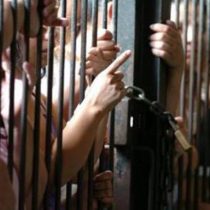
On April 4 of this year, María Jesús Fernández wrote a certain column to the Diario la Mostrador, showing that only when the inhumane prison conditions rise as a threat to the population in the free environment, have we been forced to worry about prison. This has been the case in some punctual periods of our recent history, which is worth remembering, as an exercise in beginning to question how we punish.
Since 1990 to date, there have been 3 periods when concern has turned to prison, and measures have been decreed to release large groups of the prison population:
The first was between 1990 and 1992, when the concern of Patricio Aylwin’s government was called upon to “reduce penalties and give benefits to political prisoners” (Morales, 2012, p. 102), which led to a reduction of 10.3% of the country’s detained population (Dammert, 2005, p. 39), as “the focus was on respect for fundamental rights, which resulted in a decrease in punitivism” (Cuneo, 2018, p. 157). In that case, the prison had to matter to us because thousands of people were deprived of their liberty just because they thought in a certain way contrary to the former regime, which was incompatible with any notion of democracy.
The second “episode of release” came after the fateful fire of the San Miguel Prison, where 81 people under state guardianship were killed by gross negligence of the prison authority. The rawness of that episode was again a remix for a collective consciousness that saw in prison an answer to his problems, to his insecurities and fears. The magnitude of what happened that December 8, 2010, took the daily brutality of the prison beyond its walls, and forced awareness and action. Thus, the prison had to matter to us, and this resulted in the dictation of law 20,588, on June 1, 2012, which involved the release of 4,281 persons deprived of liberty, considered “low danger”.
The third and final “released episode”, we are living it on purposes of COVID-19. In Puente Alto prison, the contagion figures as of April 24 (112 prisoners and 90 officials) exceed the total contagion of several regions of Chile, and a dangerous outbreak is being experienced in the CDP Santiago Sur. This is not only a prison problem, but an extremely serious potential public health problem, and therefore prison raises as an issue that has to matter to us. The situation has brought the prison problem, the undignified living conditions, and the need to take action on it back on the fore, resulting in a commutative pardon, more short than the previous ones, with which the sentence of 1,700 detainees was commuted.
Thus, there is a clear but fleeting awareness of the brutality that deprivation of liberty entails, but it is only when that crudeness overflows the walls of the prisons that we stop to take serious measures of release, that they pale the problem, but that in no case solve it. If you look at the figures of the population held in 1992 and then in 2012, shortly after the measures of release, the punitive rigor is resumed: the population returns to a clearly upward curve in 1992 (Dammert, 2005, p. 39), and a more downward trend but still at very high averages, in 2012 (https://www.prisonstudies.org/country/chile). Finally, it should be noted that, after the 2011 release, the available data show a significant decrease in victimization and re-victimization (ENUSC, 2018), which demystifies the less prison-crime ratio, already completely discredited at the academic level.
All this must be crossed with the characteristics of the prison population in Chile: 59% of people deprived of liberty are there for crimes against property (Gendarmerie, 2018), in a country that easily sanctions such crimes, which mostly (75%) are not violent (Citizen Peace, 2019). These are people who by 67.8%, (Gendarmerie, 2018), have a medium or low “criminal commitment”, and who are only in very low percentages convicted of crimes that threaten life (8%), or against physical integrity (3.2%).
Perhaps the context of this pandemic is an ideal opportunity for prison to never stop us from importing again, to start difficult, long, socially unpopular, but humanly and socially necessary discussions. Prison is not an effective response to the phenomenon of crime, but enhances recidivism (Larroulet, 2015), it is an area of violence and inhumanity (Leasur, 2018; UC Public Policy Center, 2017), is expensive and inefficient (Dammert, 2006, p. 17; UC Public Policy Center, 2017, p. 4 and 5), does not grant security to the population (Citizen Peace, 2019, p. 22; Cuneo, 2018, p. 186), and has no significant impact on crime (Downes, 2001, p. 51; UC Public Policy Center, 2017, p. 2), let alone prevent it (Cuneo, 2018, p.184). In that view, questioning the excessive use of pre-trial detention, differentiating notions of sanction and imprisonment, rationalizing the use of the latter (UC Public Policy Centre, 2017, p. 3) by enhancing penalties whose enforcement is at large, and limiting the hitherlessly excessive use of criminal law – which is not and cannot be a mechanism for resolving social conflicts – are first steps in a process that will delay, but must begin. Doing so does not mean enlarging impunity, but enlarging seriousness, rigor, and vision of country and public policy, and paying attention to evidence above the slogan, to serious policy over electoral profitability.
References:
UC PUBLIC POLICY CENTER (2017), “Prison System in Chile: Proposals to move towards greater effectiveness and reintegration”.
CUNEO, Silvio (2018), “Prisons and Poverty, Distortions of Criminal Populism”, Santiago: Uqbar.
DAMMERT, Lucia (2006), “The Prison System in Chile: Challenges for the New Public-Private Model”, work prepared to be presented at the Meeting of the Association of Latin American Studies of the year 2006, in San Juan, Puerto Rico, March 15 – 18.
DAMMERT, Lucia (2005), “Criminal Violence and Citizen Security in Chile”, in: ECLAC-SERIE Social Policies No. 109.
DOWNES, David (2001), “Mass incarceration in the US – a European Perspective”, in: Mass Incarceration: Social Causes and Consequences.
GENDARMERÍA de Chile (2018), “Statistical Penitentiary Compendium”.
MORALES, Ana María (2012), “Contemporary Criminal Policy: Influence in Chile of the Discourse of Law and Order”, in: Crim. Vol 7, no. 13, 94 – 146.
LARROULET, Pilar (2015), “Prison, Marginality and Crime”, in: Los Invisibles. Why poverty and social exclusion ceased to be a priority”, Institute of Society Studies.
LEASUR (2018), “Report Prison Conditions: Situation of Prisons in Chile”. Available in http://leasur.cl/wp-content/uploads/2018/12/Informe-CC-Leasur-sin-logo.pdf
PAZ CIUDADANA (2019), “Citizen Peace Index”.
The content poured into this opinion column is the sole responsibility of its author, and does not necessarily reflect the editorial line or position of El Mostrador.




